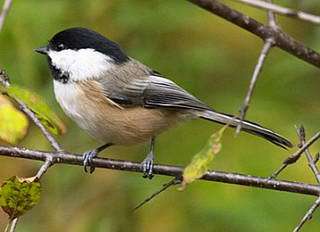Bird Calls May Have Meaning

A deep-voiced black-capped chickadee may wonder why other birds ignore it, but there may be a good reason behind the snub, says a University of Alberta study that looked into how the bird responds to calls.
Dr. Isabelle Charrier and Dr. Chris Sturdy modified the black- capped chickadee calls, played those sounds back to the bird and observed how they reacted. They found that the chickadee relies on several acoustic features including pitch, order of the notes and rhythm of the call. They also rejected the calls of the control bird, the gray-crowned rosy finch, in favour of their own species. This research is published in the current edition of the journal, “Behavioural Processes.”
The chickadees two most well-known vocalizations are the “chick-a-dee” call and the “fee-bee” song. The song is produced mainly by males and is used to attract a mate and to defend a territory during the breeding season. The learned call is produced by both sexes throughout the year and is believed to serve a variety of functions such as raising mild alarm, maintaining contact between mates and co-ordinating flock activities. They even go through stages of learning this “language,” which explains why juvenile birds can be heard frantically practicing to perfect the call.
In this study, the team—Charrier was a post-doctoral fellow in Sturdy’s lab but has since returned to France--discovered that if they raise the pitch, the bird would still respond, but if they lowered it, the chickadee stopped answering. “We speculate that this happens because the pitch may be related to size, so the chickadee thinks, ‘wow, that bird sounds big,’ and they stay away from it,” says Sturdy, from the Faculty of Science. “The first thing birds use to identify vocalizations is the frequency range. Different birds use different acoustic ranges as a filter, so if it is too high or too low, they ignore it.”
When the scientists switched around the order of the notes in the sound, the birds didn’t respond to those calls. When the space between the sounds increased—there was no different when they decreased—the chickadees stopped responding. “These changes are so slight to our ears that we wouldn’t be able to tell the difference, but a chickadee can,” said Sturdy, who adds that the way chickadees learn vocalizations is parallel to the way humans learn language. “This research shows that there is a functional aspect to these calls. Some note types may be tied to food gathering or trying to get birds around a feeder and this is laying the foundation for decoding these sounds on a fine scale.”
Sturdy said this research will help learn in which social context black-capped chickadees will be more sensitive to a particular type of calls.
Sturdy’s work was supported by a Natural Sciences and Engineering Research Council of Canada (NSERC) Discovery grant, an Alberta Ingenuity Fund (AIF) New Faculty Grant, a Canada Foundation for Innovation (CFI) New Opportunities Grant, along with start-up and CFI Partner Funding from the University of Alberta. Charrier was funded by an Izaak Walton Killam Memorial Trust Postdoctoral Fellowship and an Alberta Ingenuity Postdoctoral Fellowship.
Source: University of Alberta




















